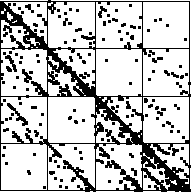| Both have a strong diagonal trend,
many points lying along the line from (1, 0) to
(0, 1) that reflect many consecutive points landing in
bin 2 and bin 3, in all combinations. |
| Both have
a reasonably strong subdiagonal trend,
points along the line from (1/2, 0) to
(0, 1/2), that reflect sometimes points
landing in bin 2 or bin 3 are followed by a
point landing in bin 1. |
| Note in both the data
and the cartoon IFS, these points landing in bin 1 are rarely
followed by another in bin 1,
because the line from (1/4, 0) to (0, 1/4) has
few points. |
| Also, both have a visible, but less strong, superdiagonal trend,
points along the line from
(1, 1/2) to (1/2, 1), that reflect sometimes points
landing in bin 2 or bin 3 are followed by a point
landing in bin 4. |



